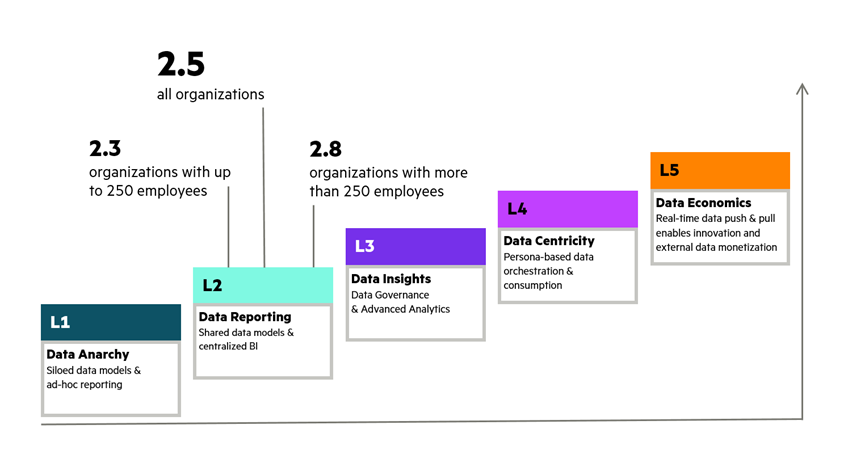Why Australian brands need to mature their data value strategies

Data holds enormous potential to advance the way we live and work. However, recent research has revealed that the limited ability to create value from data is hindering public and private sectors from achieving key business outcomes such as growing sales or advancing environmental sustainability. Indeed, unlocking the potential of data requires a shift in organisations’ digital transformation strategies.
This is according to research from Hewlett Packard Enterprise (HPE), whose global survey findings show that a lack of data capabilities is impeding organisations’ success. As an example, in Australia only 13 per cent of organisations say that their data strategy is a key part of their corporate strategy.
The survey is based on a five-level maturity model developed by HPE that assesses an organisation’s ability to create value from data based on strategic, organisational and technological criteria. At the lowest maturity level, organisations’ data pools are isolated from one another, and are not systematically analysed to create insights or outcomes. While at the highest level, organisations strategically leverage data to drive outcomes, based on unified access to both internal and external data sources analysed with AI and advanced analytics.
With these stages in mind, let’s take a look at how Australian businesses can overcome challenges associated with a lack of data capabilities.
Bridging strategic, organisational and technological gaps
HPE’s research found that the average Australian organisation’s data maturity level is 2.5 on the five-point scale outlined above. The findings also revealed that only 13% of organisations’ data strategy is a key part of their corporate strategy. Almost one-third (28%) say their organisation allocates either no budget for data initiatives or only occasionally funds data initiatives via an IT budget.
Several additional factors, such as a lack of using methodologies like ML and deep learning, or an absence of a strategic focus on data-driven products and services, collectively paint a picture of why organisations are lacking data capability. The risk for businesses is that they remain limited when it comes to advancing key outcomes such as customer experience, sustainability, sales growth, and internal efficiency.
Furthermore, creating value from data also requires aggregating data insights from different applications, locations or external data spaces. For example, a manufacturer’s sensor telemetry from sold products can help the R&D department to better align the next product generation with customer needs, just as sharing privacy-adhered insights from patient data among hospitals can advance medical diagnosis.

Most organisations are still far away from strategically leveraging data to drive outcomes. The average Australian organisation’s data maturity level – or ability to create value from data – is 2.5 on a five-point scale, with only four percent reaching the highest maturity level (“Data Economics”). Organisations with up to 250 employees have a lower data maturity level (2.3) than organisations with more than 250 employees (2.8).
Organisations want control across clouds
A characteristic of a low data maturity level is that there is no overarching data and analytics architecture, but data is isolated in individual applications or locations. This is the case for 32 per cent of Australian respondents. On the other hand, only 16 per cent have implemented a central data hub or fabric that provides unified access to real-time data across their organisation, and another eight per cent say this data hub also includes external data sources.
Given that data sources are increasingly distributed across clouds and edges, 69 per cent of respondents say that it’s strategically important to have a high degree of control over their data and the means to create value from data.
Six in ten are concerned that data monopolies have too much control over their capability to create value from data, and almost half (47%) are re-evaluating their cloud strategy due to: increasing cloud costs (54%), the lack of control over their data (49%), the need for a more flexible data architecture (45%), and concerns over data security (36%).
This is why organisations need a cloud-everywhere model with the freedom to choose the correct location for their data and applications while providing one model to orchestrate across edges, data centres and clouds. This would better allow them to control their data assets and industrialise their data supply chain through a unified data fabric that empowers decision making at speed.
Improving data maturity
Improving data maturity is no easy task. Yet, it is a key prerequisite for organisations to achieve and maintain a competitive advantage in the emerging data economy.
While there are no short cuts, a good starting point could be an assessment based on a data maturity model, which allows organisations to prioritise and tailor their plans to their individual strengths and weaknesses. For example, some organisations may be relatively advanced in terms of data technology, but fairly unwilling to share data between business units.
To be successful on this journey towards data control and sustainable, profitable growth, organizations must put data at the centre of their digital transformation. “Cloud first” used to be the catchphrase used by CIOs and CDOs. Going forward, this must be “data first”.
Dr. Eng Lim Goh is Senior Vice President, Data & AI, at Hewlett Packard Enterprise (HPE). As principal investigator of the experiment aboard the International Space Station to operate autonomous supercomputers on long duration space travel, he was awarded NASA’s Exceptional Technology Achievement Medal. His other work includes co-inventing blockchain-based swarm learning applications for finance and healthcare, which was featured on the cover of Nature; overseeing deployment of AI to Formula 1 racing; industrial application of technologies behind a champion poker bot; co-designing the systems architecture for simulating a biologically detailed mammalian brain; predicting predisposition to vaccine side effects by machine learning of gene expression data; and co-inventing a data-intensive fabric for Exascale systems. Extracting value from data is one common factor of all the above. He has eleven U.S. patents, of which 4 are ESG related; plus 2 others pending.
.
